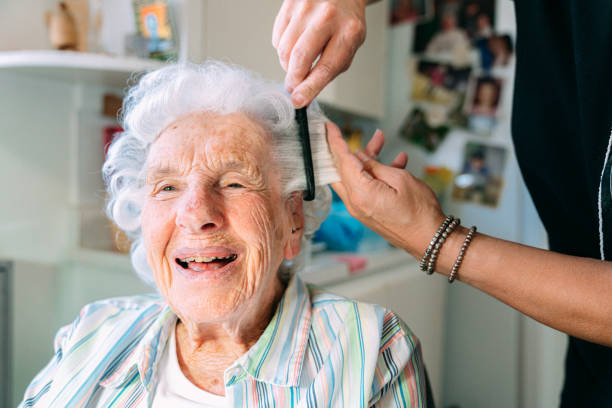Navigating the aging process can be a complex and sensitive endeavor, especially when considering the need for additional support. In-home assistance for seniors is a beneficial option that promotes independence while ensuring safety and care. However, determining the right time to seek such assistance is pivotal for enhancing the quality of life for our loved ones.
This blog post aims to shed light on key indicators and considerations to help families make informed decisions regarding in-home care for their elderly family members.
Contents
Key Indicators for Seeking In-Home Assistance
Before exploring the specifics of when to obtain in-home care, it’s crucial to understand and recognize the early signs that an elderly loved one may need assistance. These signs are not always immediately obvious, as changes can be gradual.
However, subtle shifts in their ability to manage daily tasks, changes in personal hygiene, or noticeable differences in their mood and social interactions can be clear indicators. Recognizing these signs early can make the transition to accepting in-home help much smoother and more welcomed by the seniors involved.
Decrease in Self-Care Ability
One of the primary indicators that a senior may require in-home assistance is a noticeable decrease in their ability to perform daily self-care tasks. This can include personal hygiene, dressing, eating, and mobility difficulties. When these basic needs become challenging, in-home care provides the necessary support to maintain a dignified quality of life.
Changes in Health Status
Another critical factor is a change in health status. This could be a recent diagnosis of a chronic condition, noticeable weight loss or gain, frequent injuries, or a decline in mental health. In-home caregivers can monitor health changes, manage medication, and provide companionship, contributing to a safer and healthier living environment.
Increasing Isolation
Social isolation can significantly impact a senior’s mental and emotional well-being. If a loved one begins to withdraw from social activities, they once enjoyed or has limited interaction with others due to mobility or transportation issues, in-home assistance can offer crucial social stimulation and help prevent feelings of loneliness and depression.
Evaluating In-Home Assistance Options

When considering in-home assistance, it’s important to evaluate the types of services available and determine what best fits the needs of your loved one. Various forms of in-home care cater to different requirements, from medical support to daily living activities. Understanding these options ensures that your family member receives the appropriate level of care.
Types of In-Home Care Services
There are primarily two types of in-home care services: medical (or skilled) care and non-medical (or custodial) care. Healthcare professionals provide medical care services, including wound care, injections, physical therapy, and health status monitoring. Non-medical care focuses on aiding with daily living activities, such as bathing, dressing, cooking, and light housekeeping. Some agencies offer a combination of both, providing a comprehensive approach to in-home assistance.
Selecting the Right Caregiver
Choosing the right caregiver is crucial for the comfort and well-being of your loved one. When interviewing potential candidates or agencies, consider their experience, qualifications, and personality compatibility with the senior. It’s also important to conduct background checks and ask for references to ensure reliability and trustworthiness. Additionally, involving your loved one in the selection process can help them feel more comfortable and accepting of the in-home care arrangement.
Planning for Future Needs
While your loved one may only require minimal assistance currently, it’s wise to consider their future needs. Conditions may evolve, and the necessary level of care can increase over time. Discussing long-term care options and plans with the in-home care provider can ensure a seamless transition as needs change, providing the senior and their family peace of mind.
Financial planning for in-home care is a critical aspect of the decision-making process. Understanding the costs involved and exploring available funding sources can help alleviate financial stress and ensure that your loved one receives the quality care they need without undue burden.
Understanding the Costs of In-Home Care
The cost of in-home assistance can vary widely depending on the type of care, the frequency of visits, and the geographical location. Generally, non-medical care services are less expensive than medical care services. It’s important to request detailed pricing from potential service providers and consider how these costs fit into your family’s budget. Additionally, some services may offer sliding scale fees based on income, which can make care more affordable for those on a tighter budget.
Exploring Funding Options
There are several options to consider when funding in-home care for a senior. Long-term care insurance, veteran’s benefits, and Medicaid are common sources of funding for those who qualify. Some community organizations and charities also offer grants or financial assistance to seniors needing care.
It’s also worth looking into state-specific programs supporting in-home care services. Consulting with a financial advisor who has experience in elder care funding can provide valuable insights and help identify the best options for your situation.
Preparing for Out-of-Pocket Expenses
Even with financial assistance, families often need to contribute to the cost of in-home care. Preparing for these out-of-pocket expenses is important, as well as creating a realistic budget and exploring ways to reduce costs without compromising the quality of care. Some families opt to share caregiving duties to minimize the hours of professional care needed, while others find that making certain home modifications allows their loved one to maintain independence for longer, delaying the need for extensive in-home assistance.
Navigating the financial aspects of in-home care requires careful planning and consideration. By understanding the costs, exploring all available funding options, and preparing for out-of-pocket expenses, families can make informed decisions that ensure their loved ones receive the necessary care while maintaining financial stability.
Conclusion
In-home assistance offers many benefits for seniors and their families, ranging from improved health outcomes and increased social interaction to more manageable financial burdens. By considering the types of in-home care services available, selecting the right caregiver, planning for future needs, and navigating funding options, families can make informed decisions that provide their loved ones with quality care while maintaining a sense of independence and dignity. With careful consideration and planning, in-home care can be a valuable resource for seniors to age comfortably and gracefully in their own homes.

